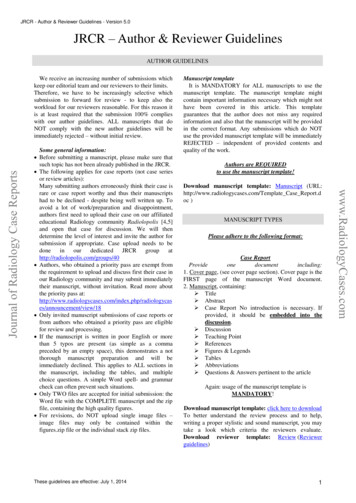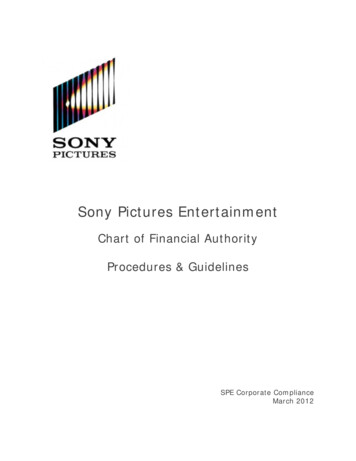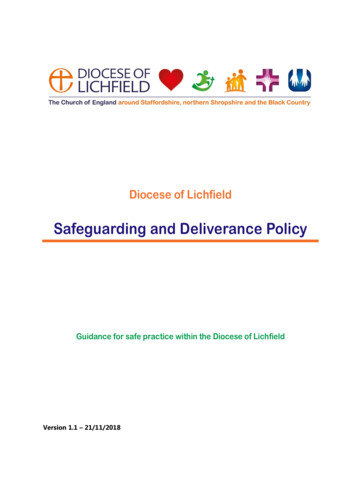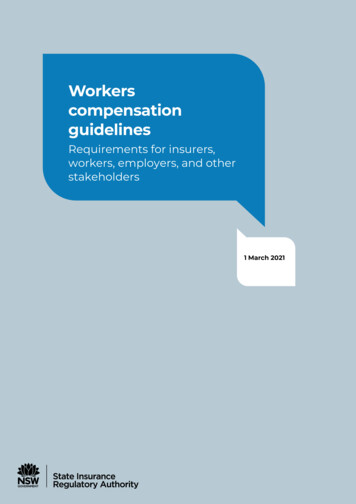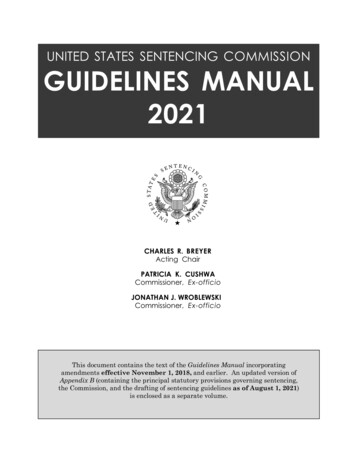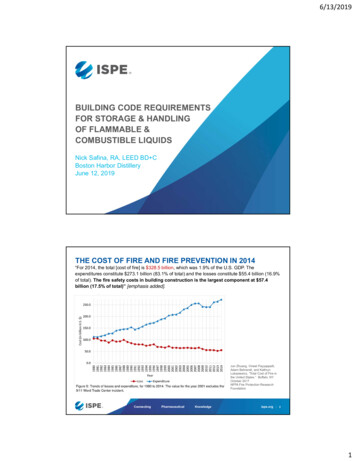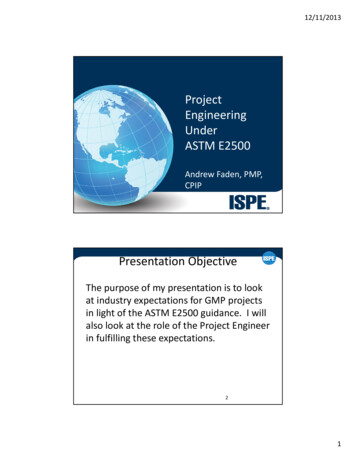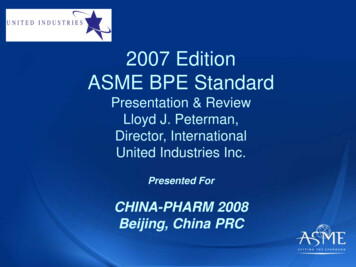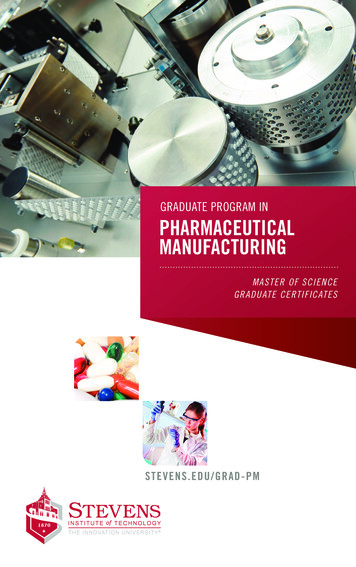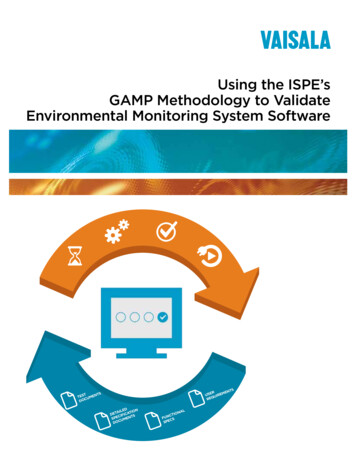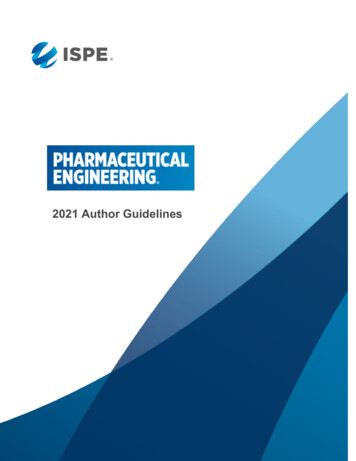
Transcription
2021 Author Guidelines
2021 Author GuidelinesContentsPART I: ABOUT PHARMACEUTICAL ENGINEERING . 4ORIGINAL MATERIAL .4Simultaneous submission .4Technical evaluation .4ACCURACY AND CORRECTNESS .5COMMERCIALISM .5ISSUE PLACEMENT .5PRINT PE AND PE ONLINE .5OPEN ACCESS .5LEGAL AND CORPORATE REVIEW .5COPYRIGHT .6PART II: WRITING YOUR ARTICLE . 7ARTICLE TYPES .7Perspectives .7Technical articles.7Case studies .7Research articles .7White papers and sponsored content .8THE EDITORIAL PROCESS .8Submission and preliminary editorial evaluation .8Peer review and revision .8Editing and approval .8USING TEXT AND GRAPHICS FROM OTHER SOURCES.9Copyright and plagiarism .9How to avoid plagiarism and properly cite the work of others .9Avoiding self-plagiarism . 10Fair use. 10Using materials from your own past publications. 10Public domain and government/regulatory content. 10Figures, tables, photos, and other graphics . 11Securing permission to use a copyrighted work . 11Published material . 11Company-supplied material . 12ARTICLE CONTENT . 12Text . 12Article title . 12Editorial style . 122 Page
2021 Author GuidelinesFigures, tables, and other graphics . 12General requirements . 13Requirements for specific graphic types . 13Units of measure . 14Equations . 14Abbreviations and acronyms . 14Acknowledgments . 14Footnotes . 14References. 14Author biography . 14PART III: SUBMITTING YOUR ARTICLE . 15CREATE AN ACCOUNT . 15SUBMIT THE ARTICLE . 16Step 1: Type, title, & abstract . 16Step 2: File upload . 16Step 3: Attributes . 17Step 4: Authors & institutions . 18Step 5: Reviewers & Editors. 19Step 6: Details & Comments. 20Step 7: Review & Submit . 20PART IV: FOR MORE INFORMATION. 21CONTACT . 21RESOURCES . 213 Page
2021 Author GuidelinesPart I: About Pharmaceutical Engineering Pharmaceutical Engineering (PE) is the flagship membership magazine of the International Society forPharmaceutical Engineering (ISPE). It is a magazine that inspires engineers, scientists, regulators, andothers in the pharmaceutical industry across all ranks, around the world, with useful articles that comefrom trustworthy and reliable sources.A bimonthly print publication and a website that includes all content from the print editions as well asoriginal Online Exclusives, PE covers topics across the spectrum of the pharmaceutical andbiotechnology industries. From technical articles that provide how-to advice that is current andimmediately applicable on the job to thought-provoking features on current issues, PharmaceuticalEngineering offers a snapshot of the profession and the industry.Pharmaceutical Engineering’s reach is global. Our readers are a diverse group: professionals workingacross all facets of the pharmaceutical, biotechnology, and manufacturing industries, as well asregulators, business leaders, academics, and students.Original materialOnly original, complete, unpublished articles will be considered for publication. We do not review orevaluate incomplete articles, abstracts, outlines, concepts, etc. This is because all subject-mattercontent is subject to peer review. We also do not publish press releases, industry announcements,executive changes, or other information being sent to multiple media.If your organization has already published the article on its website, that is considered previouslypublished content. In most cases, PE will be unable to republish this content. If you are submitting anarticle to multiple publications at the same time, PE cannot consider the content for publication.All graphic material—including tables, figures, and photographs—must be original and unpublished orin the public domain, or you must have written permission from the copyright holder to reprint theimage. It is the responsibility of the submitting author to obtain this permission. For moreinformation see the Copyright and plagiarism section.Simultaneous submissionSimultaneous submission (submitting the same article to several journals or other publications) is notpermitted. You may not submit your article to another journal or publication unless you withdraw it fromconsideration by PE or it is rejected by the Pharmaceutical Engineering Editorial Review Board.Technical evaluationIf you are an ISPE member and want to evaluate the potential of a topic or article before you write,contact the Community of Practice (CoP) that covers your technical area. These online communitiesprovide opportunities for discussion with technical experts who can offer valuable counsel. Authors whoare not ISPE members should consult resources available through their employers or universities. Theeditorial staff cannot provide an opinion about concepts, abstracts, or outlines.4 Page
2021 Author GuidelinesAccuracy and correctnessAuthors are responsible for the accuracy and correctness of all statements contained in the article;ISPE and Pharmaceutical Engineering assume no liability.CommercialismCommercialism is strictly prohibited. Commercialism is the inclusion of visual, written, or verbal references to any specific companyand/or product for promotion or commercial advantage.The article must not promote a specific product or company to the exclusion of other similarproducts that could be used to resolve the problem.The article must focus on novel and innovative technical approaches to resolve a problemwithout excluding alternative options.Issue placementYou may request publication in an upcoming issue when you submit your article. Please consult theonline Editorial Calendar for themes and conference distributions.However, final placement into an issue of the magazine depends on multiple factors, only one of whichis the editorial focus of each issue. Other factors include—but are not limited to—date of submission,duration of the review and revision process, and available space. We encourage you to take the time todevelop a solid and well-written article, not to focus on publication in a specific issue.Print PE and PE OnlinePE publishes a print magazine six times a year, every other month. The content of each issue ispublished online in two ways: the complete PDF of the print issue and individual articles (the latter areall tagged for easy searchability by topic). In addition, PE Online has Online Exclusives, content thatonly publishes on the website. Articles may be selected for publication in print/online or for OnlineExclusives. The editorial staff makes the final determination about where and when an article publishes.Open AccessTwo to three articles per current issue may be “unlocked” for non-member access (non-members arerequired to complete a short, standard form with basic information before they may view the membercontent). This affords authors the opportunity to reach a broader audience in addition to ISPEmembers. If you would like to have your article considered for Open Access if it is accepted forpublication, please indicate this when you submit your manuscript.Legal and corporate reviewIf you or any of your coauthors require legal and/or corporate review of the article before publication,you must indicate this in the cover letter when you submit the article. If your organization requireslegal or corporate review, determine the time frame required and inform the editorial staff to avoidpublication delays.5 Page
2021 Author GuidelinesCopyrightISPE retains copyright to all the articles it publishes.Once we have granted your article provisional acceptance, you must sign a copyright release andconsent to publish form.Accepted articles become the property of ISPE and may not be published elsewhere without writtenpermission from ISPE.Once published in Pharmaceutical Engineering, articles may not be posted on any website, blog site,page, or reproduced in any form without written permission from ISPE.If you want to share an article you’ve published, you may order hard-copy reprints of mostPharmaceutical Engineering articles by contacting Sheridan Content Solutions atsheridancontentsolutions@sheridan.comPE allows authors to reuse any figures, graphics, or tables that they created for their published articleand to quote up to 10% of the article text in subsequent publications or presentations withoutrequesting permission. All such use must include the following attribution:Originally published in Pharmaceutical Engineering Vol XX, no. X (Month–Month YYYY). ISPE YYYY. All rights reserved. Reprinted with permission.Requests to republish larger sections of Pharmaceutical Engineering content should be submitted tothe editorial team.6 Page
2021 Author GuidelinesPart II: Writing your articleArticle typesNOTE: All articles must be grounded in current evidence (with references to peer-reviewed literature,regulatory guidance, and credible industry resources as appropriate) and must comply with theprohibition on commercialism (see Part I).All subject-matter content is subject to peer review by industry experts. In addition to our slate ofreviewers, you may suggest additional qualified reviewers when you submit an article using the onlinemanuscript portal ScholarOne. These additional reviewers do not have to be ISPE members. There isno guarantee that the suggested reviewers will be invited to comment. (ScholarOne is further discussedin Part III.)Submissions are welcome from ISPE member or nonmember authors. These Author Guidelines applyto all submissions from all authors.PerspectivesCover recent industry developments, strategic issues, technical developments, trends, or innovativesolutions. Perspectives articles should stimulate debate, present new models or hypotheses, speculateon the meaning and interpretation of new data, or outline suggestions for future experiments.Approximate length: 1,500 words, 2 graphicsTechnical articlesPractical-application articles that define and demonstrate global best practices in engineering anddesign, product development, technology transfer, manufacturing process development and scale-up,commercial manufacturing, quality and compliance, and product life-cycle management.Approximate length: 5,000 words, 5 graphicsCase studiesCritical analyses of new approaches to industry problems. Each article should describe the method,process, and technology, discuss any difficulties encountered, and provide a balanced and supportedview of the pros and cons of this approach versus other, more established methods.Approximate length: 4,000 words, 4 graphicsResearch articlesArticles describing innovative methods and techniques related to any aspect of the pharmaceuticalindustry. They must emphasize sound research methods and results, with conclusions supported byadequate evidence. Scientific rigor and reproducible results are required.Approximate length: 4,000 words, 4 graphics7 Page
2021 Author GuidelinesWhite papers and sponsored contentPharmaceutical Engineering Online accepts White Papers and Sponsored Content. These paid contentformats are managed by the Advertising Sales Group. Contact Carol Nettles, Advertising SalesManager, cnettles@ispe.org or JT Hroncich, Advertising Sales Manager, jhroncich@ispe.org for currentrates and additional information. White Papers and Sponsored Content do not undergo peer review,and are published only online (not in the print magazine). Content requires sign off by the editorialteam.The editorial processSubmission and preliminary editorial evaluationAuthors of perspectives, technical articles, case studies, and research articles should submit theirmanuscripts through Pharmaceutical Engineering’s online portal, ScholarOne Manuscript Central (seePart III for detailed instructions).When a submission is received, PE editorial staff will perform a preliminary assessment of its potentialsuitability for publication. Manuscripts that meet the basic criteria for a PE article move forward in theeditorial process. Authors will be notified if their manuscripts will not move forward or need additionalwork before moving forward.Peer review and revisionPE uses a double-blind peer review process: authors and reviewers are not identified to each other.Peer review generally takes several weeks. Editorial staff are unable to guarantee completion of peerreview within a set time period.After your manuscript is reviewed, you will receive a decision email that details reviewer feedback. Ifrevisions are required, you will be given a deadline for submitting a revised draft. Revision timelines willdepend on the level of revision requested; two to six weeks is typical.When revising a peer-reviewed article, please used Tracked Changes in the manuscript. Also, pleaseinclude a point-by-point response to the reviews so that it is clear that you have addressed the reviewerfeedback in full.If a revision meets the reviewers’ expectations and editorial requirements, the manuscript will beprovisionally accepted and moved forward to editing. Some manuscripts may require more than oneround of review/revision before they are provisionally accepted.Editing and approvalAll content provisionally accepted for publication in Pharmaceutical Engineering will be edited for style,tone, flow, cohesion, and organization. This includes formatting references. ISPE reserves the right toedit, revise, and delete text or graphics as appropriate.The edited manuscript will be returned to the authors for their review and approval. At this point,authors must also submit final graphics, their completed copyright transfer/author information forms,and any supporting documentation required to publish their article.8 Page
2021 Author GuidelinesUsing text and graphics from other sourcesCopyright and plagiarismCopyright laws protect original works by requiring permission from the author (or publisher, whoacquires rights from the author) to reuse or adapt it.Plagiarism is using another person’s work—copyrighted or not—and representing it as the product ofyour own effort.All PE authors must respect copyright requirements and avoid plagiarism (including selfplagiarism and plagiarism from public domain resources). For more information, see theResources at the end of the Author Guidelines.How to avoid plagiarism and properly cite the work of othersWhen you refer to the work of others in your article, you need to make sure that you do it the right way.You can avoid plagiarism by restating in your own words ideas or information derived from othersources. (Note: Changing a few words or reorganizing phrases and sentences is insufficient.) Also,each time that you restate ideas or information, be sure to provide numbered endnote references forevery source of the material.Another option is to use a direct quote from the source, then add a reference and cite the source fromwhich you copied the text. The length of a quotation should usually be limited to a maximum of a fewsentences or a paragraph.Here are some illustrative examples:Original wording from sourceThe emergence of “big data” has allowed pharmaceutical organizations to harness the vastamount of information they generate.Insufficient tweak“Big data” has allowed pharmaceutical organizations to harness the information they generate[1].Appropriate restatementAs metrics and statistics have evolved into “big data,” the pharmaceutical industry has learnedhow to tap the enormous reservoirs of information it produces [1].QuotationAs Ingram et al. noted, “The emergence of ‘big data’ has allowed pharmaceutical organizationsto harness the vast amount of information they generate” [1].-----------------------------------1. Ingram, M., A. B. Pazhayatti, N. Sayeed-Desta, and G. Ayyoubi. “Manufacturing Excellence Utilizing a Life CycleApproach.” Pharmaceutical Engineering 37, no. 5 (September-October 2017): 67–69.9 Page
Avoiding self-plagiarismSelf-plagiarism occurs when an author reuses material (text or graphics) that they have publishedpreviously without acknowledging the source of the material. To avoid self-plagiarism, restate or quoteyour previously published work and include references. See also “Using text or graphics copied fromother sources” (below).Fair useEven when you properly cite content, there can still be problems with copyright infringement. In theUnited States, a legal standard called “fair use” allows “limited” use of copyright-protected works fordiscussion or analysis. In a scholarly or technical work (such as a PE article), you can use “shortpassages” of text for illustration, comment, or clarification. Generally, tables, figures, illustrations, andphotos cannot be reused without permission of the copyright holder.Using materials from your own past publicationsAuthors of published books or articles usually do not own the copyright to those materials. If your PEarticle includes text from a work you published elsewhere, be sure that the quoted material does notexceed the bounds of your agreement with the initial publisher, and that you clearly indicate in your PEarticle what material is quoted.If your article contains graphics that you previously published, you will need permission from thecopyright holder to reuse them in PE. You must also supply a credit line/attribution to document thematerial’s source and copyright holder; this text is usually supplied by the original publisher.Public domain and government/regulatory contentContent that is in the public domain can be used without applying for permission from a copyrightholder. (Works in the public domain are works where the copyright has expired or works that have beenpublished without copyright protection.)Although you do not need permission to use content or graphics from public domain works, you stillmust provide citations/references. Additionally, use quotation marks when you copy public domaincontent verbatim.Note that not all information on the Internet is public domain content! Even some governmentpublications are not in the public domain. Here are some examples: In the United States, most (but not all) work published by the federal government is in the publicdomain. Agency logos are usually trademarked, which means permission may be required touse graphics that include logos.Works produced by United Kingdom departments and agencies may be available under anopen government license; if not, they may be subject to Crown Copyright.Most European Union documents, including EudraLex data, may be used without applying forwritten permission, provided the source is acknowledged.It is always wise to check websites, review the copyright information in print publications, orcontact publishers to determine whether a source is copyrighted or in the public domain.
2021 Author GuidelinesFigures, tables, photos, and other graphicsUnless it’s clear that a graphic is in the public domain, you must assume that it’s protected by copyrightand permission is required to use it. Consider these misconceptions about copying graphics:I’ve cited the source: It is not permissible to use a figure, photo, or table (or portion of it) withoutpermission even if you acknowledge the source. Unless the item is in the public domain, using it withoutpermission may be copyright infringement.I’m not using much: It doesn’t matter how large the original work is, or how much of it you’re using. Ifyou want to borrow a figure, photo, or table, you must have the copyright holder’s permission.I’m going to modify it: Incorporating new material into a copyrighted graphic or figure may producewhat is known as a “derivative work.” This can only be done with authorization from the originalcopyright holder, and must usually be credited as “adapted with permission.”It’s from a nonprofit organization: Nonprofit doesn’t mean public domain. Some organizations, likeICH, allow material to be used without permission as long as they are identified as the copyright holderand any modifications to the original are noted. Others, like ISO and ISPE, require written permission torepublish material. Be sure to check the organization’s website for reuse parameters and contactinformation.It’s from an open source publication: Open source publications are copyrighted, although thepolicies for reusing graphics may be different than those for traditional publications. You must reviewthe open source publication’s copyright language/license and follow the publisher’s instructions withregard to reusing material. Even if the publisher’s license allows for reusing material without seekingpermission in advance, you must provide correct attribution to the original publication and copyrightholder.Securing permission to use a copyrighted workTo avoid copyright issues, we encourage authors to create original graphics (including tables, charts,and graphs) for their articles whenever possible. As noted earlier, if authors choose to use copyrightedgraphics, they are responsible for obtaining written permission or a copy of the license from thecopyright holder and providing the documentation to Pharmaceutical Engineering. Authors are alsoresponsible for paying any permissions fees.Published materialYou must identify materials copied from (or based on) outside sources both in your manuscript and inyour cover letter when you submit the article to PE.When requesting permission from a publisher or other organization to use copyrighted materials, checktheir website for instructions and the appropriate contact person. Generally, you must supply thefollowing information in your request: Title of the original work: The book, journal article, online publication, website, or other sourcein which the figure first appeared—and that may not be the work in which you found it. Pleasebe aware that you may have to do some research to find the copyright owner.11 P a g e
2021 Author Guidelines Author of the original work: The person who wrote the book, article, or paper in which thefigure or table first appeared. If your source is a book that contains chapters by multiple authors,you will need to provide the name of the book author/editor and the chapter author.Publisher: The company (e.g., Elsevier, Springer, ACS) that published the book or journal inwhich the figure first appeared.Publication information: Book: Chapter title, pa
only publishes on the website. Articles may be selected for publication in print/online or for Online Exclusives. The editorial staff makes the final determination about where and when an article publishes. Open Access Two to three articles per current issue may be "unlocked" for non-member access (non-members are
